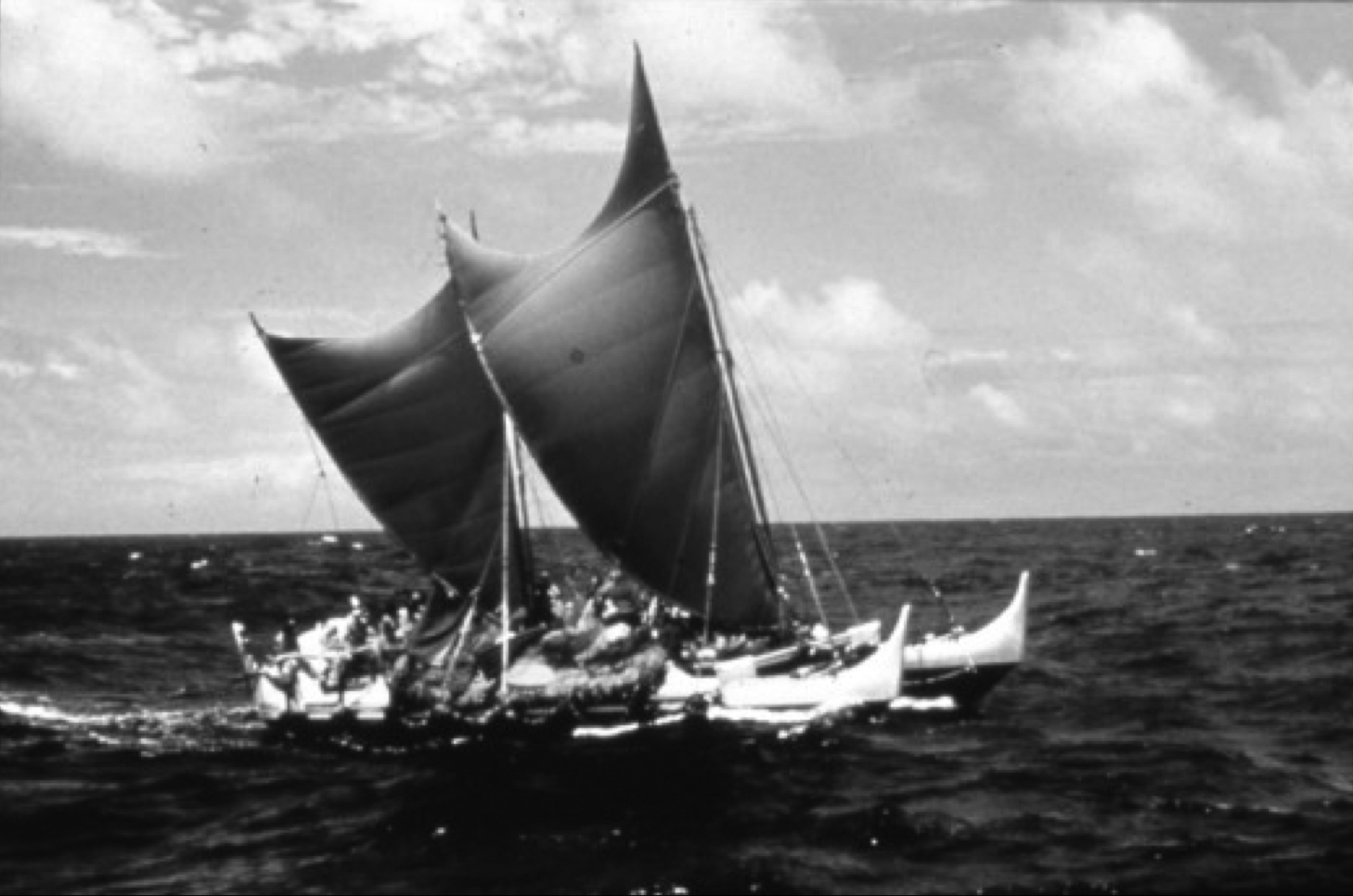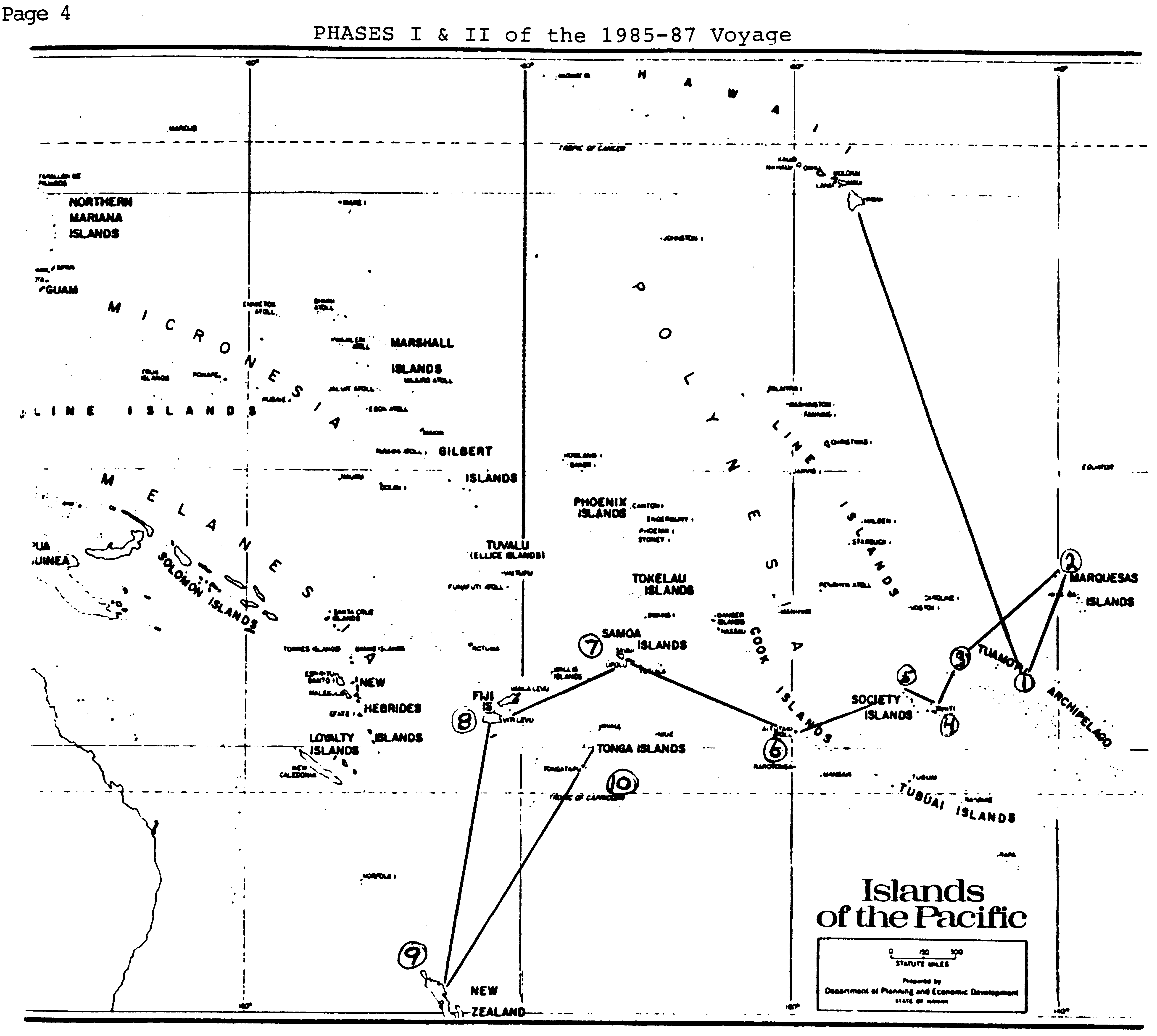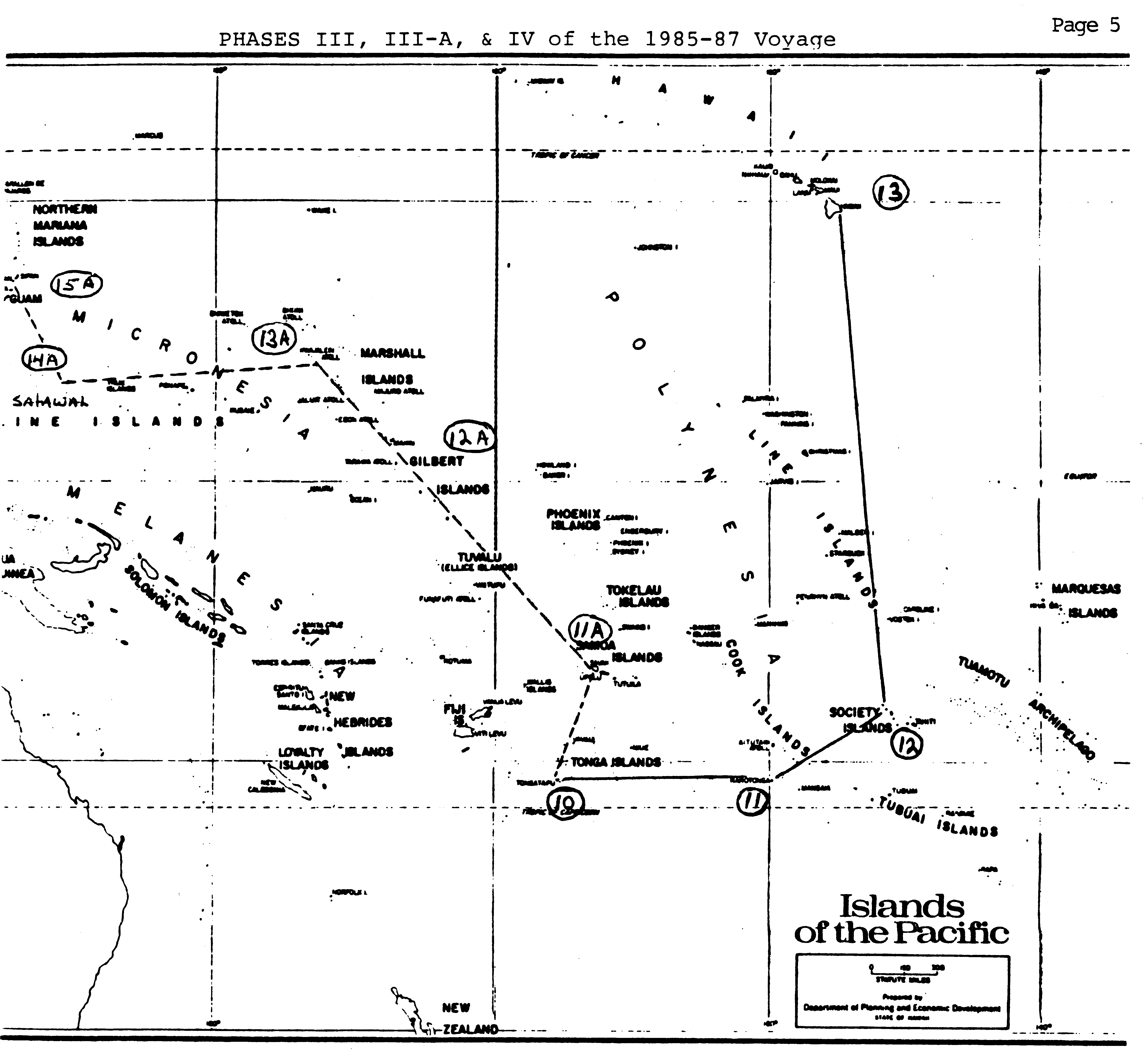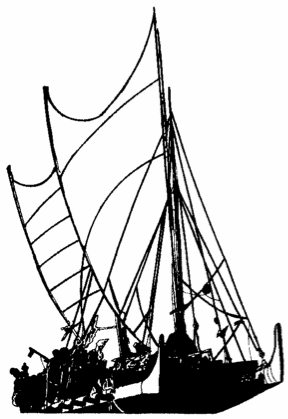PVS Newsletter / March-April 1984
Hokule‘a
Ka Wa‘a Kaulua
ANNOUNCING THE MOST FANTASTIC VOYAGE YET
THE 1985-87 HOKULE'A VOYAGE TO THE SOUTH PACIFIC!
The driving force behind the activities of the Polynesian Voyaging Society has been a dream... a dream of bringing the people of the Pacific Islands closer together. Closer by way of traditional, non-instrumental naviaation as Practiced by Polynesians of earlier times. Closer by showing how it was done ... and actually doing it. Doing it with an actual vessel. The Hokule'a wa'a kaulua, the doublehulled canoe.

Hawaii's link with Tahiti has been enriched and solidified with the accomplishments of the Hokule'a canoe. Finally, the legends and chants of voyaging handed down by our forefathers were shown to be based in fact. And the accompanying pride that rose with the successful Hokule'a voyages has helped to rekindle pride in other aspects of Hawaiian culture.
We at Polynesian Voyaging Society have been gratified with the success of the 1976 and 1980 roundtrips to the Society Islands. But for the past year, we have been hard at work at an even bigger dream... to have Hokule'a become a uniting force among all the Pacific island Peoples through increasing an understanding of the seafaring heritage common to all. Feasibility studies have been done, trips have been taken to different regions of the Pacific, fundraising efforts are well underway. And so in late 1983, the Polynesian Voyaging Society's Board of Directors approved a voyage to begin in 1985. A voyage whose dimensions have far surpassed anything that has been done before. P. voyage that is projected to take 2 ~years to complete. A voyage that will take Hokule'a from Hawaii to the Tuamotu Archipelago, Marquesas Islands, Tahiti and the rest of the Society Islands, Rarotonga and the Cook Islands, Samoa Islands, Fiji Islands, New Zealand, and the Tonga Islands. On February 26th at the Annual Membership Meeting held at the Theatre of the Honolulu Academy of Arts, PVS made the first public announcement of Hokulela's 1985-87 voyage to the South Pacific!
We have dreamed of such a voyage from PVS' earliest days. But the 1976 and 1980 voyages themselves needed so much time and effort to accomplish, that we were not s*ure that a dream of of such magnitude was possible. So we decided to look at the PVS organization in 1982 and memorialize in writing what we were and what the future might hold for us. We evolved what we call the:
PVS MISSION STATEMENT
The mission of the Polynesian Voyaging Society (PVS) is to increase our knowledge of the ancient Polynesian culture by keeping Hokule'a sailing.
This performance-accurate replica of a double-hulled voyaging canoe is our way of discovering the roots and value systems of the Polynesians of old, our way of getting in touch with the creativeness and ingenuity that enabled a venturesome people to sail far and wide and to occupy a huge Dortion of this planet.
Ocean-oriented experiences as provided by Hokule'a increase our understanding of the complexity of the problems that ancient navigators solved as they sailed to intended destinations over vast Pacific distances.
During its first eight years of existence, Hokule'a has completed two round trip voyages to Tahiti, attempted another, investigated Kealaikahiki as a possible "Path to Tahiti," and traveled extensively throughout the islands of Hawaii on several educational ventures.
The 1976 voyage of Hokule'a showed that the canoe could "hold close to the wind," and that the wayfinding art could assure successful landfall. Hokule'a 1980 showed that it is possible to develop a wayfinding system that can assure round-trip voyaging between Hawaii and Tahiti.
The navigators, Pius Mau Piailug and Nainoa Thompson, demonstrated the wayfinding art by sailing Hokule'a over 15,000 kilometers of open ocean to successful landfalls. Continued voyaging will increase our knowledge of wayfinding.
The objectives of the 1985-87 voyage of Hokulela are several:
- Expanding our knowledge of the practice of seafaring arts on a traditional type of vessel.
- Furthering our knowledge of the problems that the navigator faces and, by extension, how the ancierits might have solved such problems.
- Locating tiny island targets over long oceanic distances under a variety of climactic conditions and sailing directions.
- Increasing an understanding and unity among Pacific island peoples of their common seafaring heritage.
- Providing sailing opportunities so that others may experience, as Nainoa has expressed it, "that privileged moment of looking through a window into my heritage."
We are looking at the Polynesian phenomenon from three vantage points-culture, science, and the humanities.
Culture - The canoe as the culmination in art form and engineering design of the peoples of Oceania; long distance voyaging as their ultimate intellectual endeavor. In the fusion of mind and canoe was their means of attaining the hopes and dreams spoken of in chant, song, dance, and story.
Science - Science is both product and process'that allows us to examine the elements in the wayfinding system that Nainoa invented and to gain an insight into the cognitive structures and heuristic processes embedded within the wayfinding art.
Humanities - How does the ocean shape the mind and is in turn shaped by it? What mode of thinking emerges from an oceanic people and how does that affect language? The disciplines of history, religion, and philosophy provided perspective.
The voyages of Hokule'a have given us an insight into the art of wayfinding. Our knowledqe is rich and will increase as the canoe continues sailing in search of the mind of the ancient Polynesian.
The PVS Board of Directors adopted the PVS Mission Statement as a foundation for the future endeavors of Hokule'a, starting with the 1985 trip. How were we to accomplish this? Easy, at least in thought ... sail Hokule'a to new horizons across the vast Pacific Ocean to different island peoples who have heard of, but never truly experienced, our double-hulled canoe. And so we announce the 1985-87 voyage.
THE NAVIGATIONAL SAIL PLAN
The truest approach to an understanding of traditional navigation is through the practice of traditional sailing. Within the means of the Polynesian Voyaging Society is the canoe, Hokulela, the sailors, the organization, and the accomplishments of the 1976 and 1980 voyages.
The proposed sail plan of the voyage endeavors to further the knowledge base and the understanding of traditional navigation.
Each of the proposed sailing legs has its own unique navigational experience. There are no two legs that are similar in terms of the course, the sailing strategy and,targetting of landfall. The act of such sailing experience is an exercise in both the science and the art of traditional navigation. The completion of such a voyage would bring a respect that is so richly deserving of the accomplishments of ancient Polynesian mariners.
The accompanying maps illustrate the general sail plan of the 1985-87 voyage. Thepolan is based heavily on the most practical and safest way to sail through the major island grouos of Polynesia. Each leg has been set with a mind to the time of year, weather conditions, currents, and length of voyage. Keep in mind that it may have taken the early Polynesians 1,000 to 1,500 years to accomplish what we want to partially replicate in two and a half years--not an easy task by any means. The individual sailing routes and their respective time frames are based mainly on research into climatology and information-gained from individuals who have sailed within the Pacific area. This general plan is of course subject to adjustments, as the logistics of the overall plan evolves within the next year.
We forsee 3 phases in the navigational sail plan:
Phase I - March 1985 to September 1985: Hawaii to Fiji.
The individual sailing legs are: Hawaii-Tuamotus (30 sailing days), Tuamotus-Marquesas (6), Marquesas-Tuamotus (6), Tuamotus-Tahiti (2), Tahiti -Societies (3), Societies-Cooks (12), Cooks-Samoa (14), & Samoa-Fiji (9), for a total of 82 sailing days.
Phase II - December 1985 to March 1986: Far South Pacific.
The individual sailing legs are: Fiji-New Zealand (15), New Zealand-Tonga (15), totalling 30 sailing days.

Phase III - May 1986 to August 1986: Entering Central Polynesia.
Individual legs: Tonga-Cooks (25-45), Cooks-Raiatea (20-35), for a total of 45-80 sailing days.
However, it is well realized that Hokule'a may encounter great difficulty to sail directly eastward during this time period, and taking into account the weather and currents. So we have an equally intriguing alternate route to consider:
Phase III-A - May 1986 to March 1987: Going west to Guam.
Individual legs: Tonga-Samoa (8), Samoa-Gilbert Islands (14), layover to January 1987, then Gilberts-Marshall Islands (8), Marshalls-Carolines (SATAWAL, Mau's home) (14), Satawal-Guam (7), for a total of 51 sailing days. Hokule'a would then be shipped back to Hawaii.
Phase IV - May to June 1987: from Raiatea to Hawaii, if we are able to make the easting in Phase III to get back to Raiatea. A total of 28 days of sailing.

Of course all these figures for the estimated sailing times are only qeneral guidelines for the length of each proposed sailing leg. And there may be many stops in the various island chains Hokule'a enters.
So there it is... the most challenging, all-encompassing, mindboggling voyage to date for PVS' Hokule‘a!
For accounts of the 1985-1987 Voyage of Rediscovery, see Ben Finney’s “Voyage of Rediscovery: 1985-87” and Nainoa Thompson’s “Recollections of the Voyage of Rediscovery: 1985-1987.”
Hokule‘a Ka Wa'a Kaulua, A New Film on Hokule‘a
The upcoming voyage to the South Pacific is not the only thing we're excited about at PVS! The premiere of Hokule‘a Ka Wa'a Kaulua premiered at the Annual Membership Meeting. Our congratulations on a beautiful film, Chuck Larson ... your endless hours of work both here and in Washington, D.C. paid off. PVS members and friends should watch for public announcements of future showings of the film. What follows is part .of the Official Program Guide for "Hokulela Ka Wa'a Kaulua":
The Polynesians began with the canoe. Before European open ocean exploration began, theg had discouered everg habitable island with the Earth's largest Ocean.
Hawaii, first discovered by Marquesans, was the most remote of the Polynesaon settlements. Chants and legends tell of the later arrvual of Tahitian chiefs in the fifth century and of the legendary travels of Mo'ikeha, Pa‘ao and others who sailed back and forth between the two centers in the 12th and 13th centuries.
To retrace those legendary two-way vogages, the Polynesian Voyaging Society was formed and the Hokule'a, a 60 foot double hulled canoe was built. In 1975, multi-racial members of the PVS built a performance replica of an ancient Hawaiian voyaging canoe. As part of Hawaii's contribution to the bicentennial celebration in 1976, theg sailed it to Tahiti and back
After Hokule'a made its historical first voyage to Tahiti, the National Geographic Society made a 90 minute film which has been described as a chronicle of confiict. Its theme was dramatic and centered around the racial conflict in the crew. Because of its length and theme, it frequently was not appropriate for educational use.
To make a new film suitable for educational use become a goal of the Polynesian Voyaging Society. Using the 180 hours of unused National Geographic Society film that rernained from the initial project, a new film was made titled "Hokule'a - Ka Wa'a Kaulua". While giving some historical background, the new film strives to give an impression of what it was like on the 1976 voyage.
So the film could be appreciated by limited English speaking audiences, it strongly relies on visual and musical impressions to convey its feelings.
Although produced, written and edited by Chuck Larson, this new film is the result of contributions by many. Without the technical assistance, support and equipment of Bob Liljestrand, the film neuer would have first been considered He was the guidance and teacher.
The excellent film crew of the National Geographic Society and all their resources, of course made the project possible. All of the scenes in this film came from the outtakes of their original project.
Lois Loomis and the McInerny Foundation provided the initial and greatest financial support. Their faith made it possible for others to participate.
Jack de Mello and Music of Polynesia, Inc., provide the film with its beautiful musical sound track which came from the album "The Musical Saga of the Hokule'a". The lyrics and chants are by Keli'i Tau'a and the music by Roland Cazimero.
Palani Vaughn donated his time and unique talent to record the narration, and Kapono Beamer contributed the original noseflute music. Sam Ka'ai provided the conch shell effects and Ross Reed gave up his kitchen for an editing room. The writings and advice of Ben Finney and Herb Kane provided the basic information for the narration, and Will Kyselka assisted with its editing.
Financial assistance also came from the State Foundation on Culture and the Arts, the Hawaii Committee for the Humanities and the Lawrence Brown Foundation.
The credit for producing this program and all around general inspiration for this film belongs to Marlene Among.

